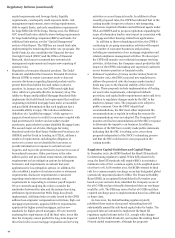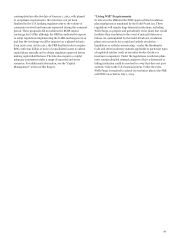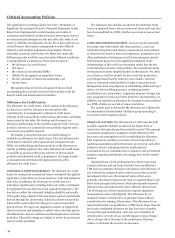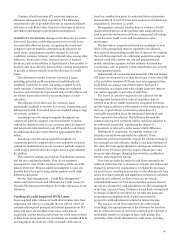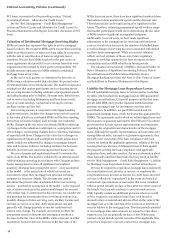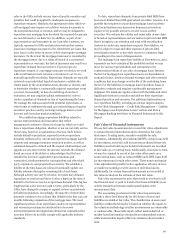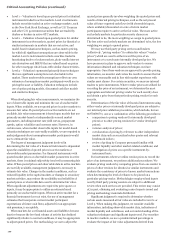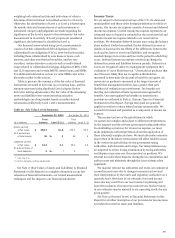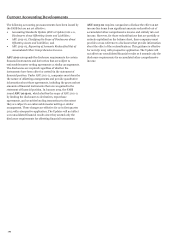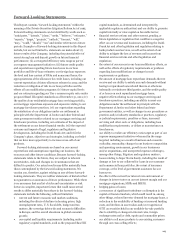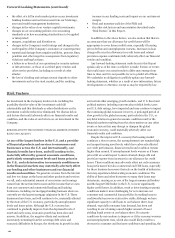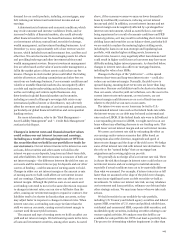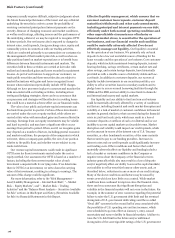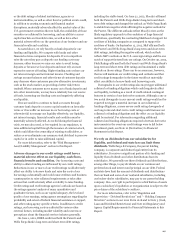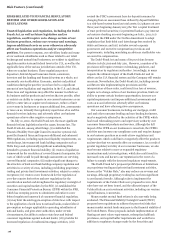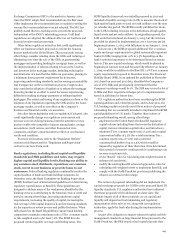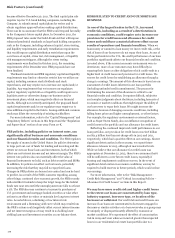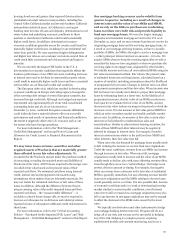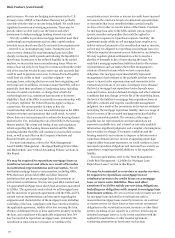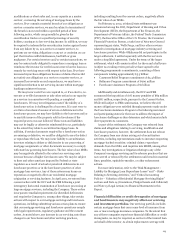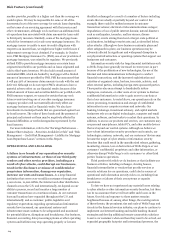Wells Fargo 2012 Annual Report Download - page 106
Download and view the complete annual report
Please find page 106 of the 2012 Wells Fargo annual report below. You can navigate through the pages in the report by either clicking on the pages listed below, or by using the keyword search tool below to find specific information within the annual report.
Forward-Looking Statements (continued)
x the effect of a fall in stock market prices on our investment
banking business and our fee income from our brokerage,
asset and wealth management businesses;
x changes in the value of our venture capital investments;
x changes in our accounting policies or in accounting
standards or in how accounting standards are to be applied
or interpreted;
x mergers, acquisitions and divestitures;
x changes in the Company’s credit ratings and changes in the
credit quality of the Company’s customers or counterparties;
x reputational damage from negative publicity, protests, fines,
penalties and other negative consequences from regulatory
violations and legal actions;
x a failure in or breach of our operational or security systems
or infrastructure, or those of our third party vendors and
other service providers, including as a result of cyber
attacks;
x the loss of checking and savings account deposits to other
investments such as the stock market, and the resulting
increase in our funding costs and impact on our net interest
margin;
x fiscal and monetary policies of the FRB; and
x the other risk factors and uncertainties described under
“Risk Factors” in this Report.
In addition to the above factors, we also caution that there is
no assurance that our allowance for credit losses will be
appropriate to cover future credit losses, especially if housing
prices decline and unemployment worsens. Increases in loan
charge-offs or in the allowance for credit losses and related
provision expense could materially adversely affect our financial
results and condition.
Any forward-looking statement made by us in this Report
speaks only as of the date on which it is made. Factors or events
that could cause our actual results to differ may emerge from
time to time, and it is not possible for us to predict all of them.
We undertake no obligation to publicly update any forward-
looking statement, whether as a result of new information, future
developments or otherwise, except as may be required by law.
Risk Factors
An investment in the Company involves risk, including the
possibility that the value of the investment could fall
substantially and that dividends or other distributions on the
investment could be reduced or eliminated. We discuss below
risk factors that could adversely affect our financial results and
condition, and the value of, and return on, an investment in the
Company.
RISKS RELATED TO THE ECONOMY, FINANCIAL MARKETS, INTEREST
RATES AND LIQUIDITY
As one of the largest lenders in the U.S. and a provider
of financial products and services to consumers and
businesses across the U.S. and internationally, our
financial results have been, and will continue to be,
materially affected by general economic conditions,
particularly unemployment levels and home prices in
the U.S., and a deterioration in economic conditions or
in the financial markets may materially adversely affect
our lending and other businesses and our financial
results and condition. We generate revenue from the interest
and fees we charge on the loans and other products and services
we sell, and a substantial amount of our revenue and earnings
comes from the net interest income and fee income that we earn
from our consumer and commercial lending and banking
businesses, including our mortgage banking business where we
currently are the largest mortgage originator in the U.S. These
businesses have been, and will continue to be, materially affected
by the state of the U.S. economy, particularly unemployment
levels and home prices. Although the U.S. economy has
continued to gradually improve from the depressed levels of
2008 and early 2009, economic growth has been slow and
uneven. In addition, the negative effects and continued
uncertainty stemming from the sovereign debt crisis and
economic difficulties in Europe, the slowdown in growth in Asia
and certain other emerging growth markets, and U. S. fiscal and
political matters, including concerns about deficit levels, taxes
and U.S. debt ratings, have impacted and may continue to impact
the continuing global economic recovery. A prolonged period of
slow growth in the global economy, particularly in the U.S., or
any deterioration in general economic conditions and/or the
financial markets resulting from the above matters or any other
events or factors that may disrupt or dampen the global
economic recovery, could materially adversely affect our
financial results and condition.
Despite the improved U.S. economy the housing market
continues a slow recovery, the unemployment rate remains high
and nonperforming asset levels, which have adversely affected
our credit performance, financial results and condition remain
higher than normal. If unemployment levels worsen or if home
prices fall we would expect to incur elevated charge-offs and
provision expense from increases in our allowance for credit
losses. These conditions may adversely affect not only consumer
loan performance but also commercial and CRE loans, especially
for those business borrowers that rely on the health of industries
that may experience deteriorating economic conditions. The
ability of these and other borrowers to repay their loans may
deteriorate, causing us, as one of the largest commercial lenders
and the largest CRE lender in the U.S., to incur significantly
higher credit losses. In addition, weak or deteriorating economic
conditions make it more challenging for us to increase our
consumer and commercial loan portfolios by making loans to
creditworthy borrowers at attractive yields. Although we have
significant capacity to add loans to our balance sheet, loan
demand, especially consumer loan demand, has been soft
resulting in our retaining a much higher amount of lower
yielding liquid assets on our balance sheet. If economic
conditions do not continue to improve or if the economy worsens
and unemployment rises, which also would likely result in a
decrease in consumer and business confidence and spending, the
104


